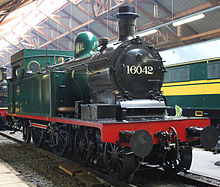|
Caledonian Railway 721 Class
The Caledonian Railway 721 Class (known as the "Dunalastair" class) was a class of 4-4-0 steam locomotives designed by John F. McIntosh for the Caledonian Railway (CR) and introduced in 1896.[1] Taking their name from the estate in Perthshire owned by the Caledonian’s then deputy chairman, J.C.Bunten, all survived to be absorbed by the London, Midland and Scottish Railway (LMS) in 1923 and a few survived into British Railways (BR) ownership in 1948. DevelopmentThe "Dunalastair" class marked a new era of development in late-Victorian British steam locomotive design.[2] The average weight of passenger trains had greatly increased in the 1880s and 1890s due to the demand for more comfortable, better-appointed and safer carriages.[3] Combined with continually rising passenger volumes and the competition between railway companies to offer faster services and locomotive engineers were faced with producing engines that could operate longer, heavier trains at faster speeds. The existing pattern of inside-cylinder 4-4-0 express engine was reaching the limits of its development and many railways were resorting to the inefficient practice of double heading to maintain schedules.[4] McIntosh provided the solution with the original "Dunalastair" of 1896. In broad design this was identical to the conventional 4-4-0 engine drawn up by his predecessor Dugald Drummond,[2] but it carried a boiler significantly larger than was usual for the time - almost to the full limits that the Caledonian's loading gauge would allow, operating at a relatively high pressure of 160 psi (1,103 kPa). The boiler also contained more fire tubes of a greater diameter than its predecessors, greatly increasing its steam generating capacity and overall steam volume. While the top speed of the 721 Class and its developments was largely the same as other express 4-4-0s the more productive and capacious boiler meant the type offered a hugely improved ability to maintain high speeds with heavy loads on steep gradients, allowing the "Dunalastairs" to set high average speeds over the Caledonian's arduous main line over Beattock Summit.[2] So confident was McIntosh that his new engine would do away with the need for double heading that the "Dunalastairs" were originally built without brake hoses on their front buffer beam, meaning that a second engine could not be coupled to them. The principles of the 721 Class and its boiler were adopted by many other locomotive engineers and railways in the 1890s and early 20th century, leading to the so-called 'big engine' period of design. Other engine classes such as the GNR Class C1 and the GWR 4100 Class were inspired by the success of the "Dunalastairs".[2] The class was very successful and developed in four different versions:[5]
The rebuilding with superheaters was accompanied by a reduction in boiler pressure and an increase in cylinder diameter. There are two further classes of McIntosh 4-4-0 locomotives which some authors have included in the Dunalastair series. These are:
 During the national coal strike of 1912, some Caledonian locomotives, including Dunalastairs or 139 class engines[additional citation(s) needed], and two engines from class 812[1] were fitted with Holden oil burners for a short time. They received a 520 imperial gallons (2,400 L) fuel tank atop the tender and more refractory bricks in the firebox.[6] TendersClasses 766 and 900 were built with eight-wheel bogie tenders with capacities for 4,125 imperial gallons (18,750 L) of water and 4.5 tons of coal. In the 1930s newer and more powerful LMS locomotives took over their most long-distance duties and the company cascaded the 900 Class to other work. This made eight-wheel tenders superfluous so the company substituted smaller, lighter and simpler six-wheel tenders from scrapped Caledonian locomotives. Most members of the class received McIntosh tenders that had been built for classes 179, 600, 908 and 918. The six-wheel tenders had the same 4.5 ton coal capacity but carried only 3,570 imperial gallons (16,200 L) of water.[7] NamesThe Caledonian named only a handful of locomotives, eleven in total, five of which were Dunalastairs:
No. 766 was the first of the "second class of Dunalastairs". It took the name Dunalastair 2nd but this was likely very short-lived, perhaps only between May and June 1898. Beyond this, it appears to have simply worn the name Dunalastair and seemingly never wore the Roman 'II' as is often quoted. What is certain is the name was removed completely before 1914. Accidents and incidents
Dimensions
Numbering
The 139 Class and 43 Class are included in the Dunalastair series by some authors. Some locomotives survived into British Railways (BR) ownership in 1948.[11][12][13][14] Notes
Belgian derivatives  The Belgian State Railways (SNCB-NMBS) derived six series of steam locomotives (424 units) from the Dunalastair design between 1899 and 1913:[15][16]
Two of them are preserved in cosmetic state by SNCB: 4-4-2 tank locomotive 16.042 and express locomotive 18.051.[17][18] 18.051 also features an eight-wheel bogie tender similar to the Caledonian eight-wheel tender. This kind of tender was used on Type 17 and some of the first Type 18 while the rest (including 18.051) had wider and larger six-wheel Belgian tenders. That one was salvaged when 18.051 was restored and was originally built for an older Type 18. WithdrawalThe first Dunalastair to be withdrawn from service after Quintinshill was No. 14343 in 1933, though the reason for this was unclear. The next withdrawal was not until 1937, but by 1944 only five members of the 900 Class remained. The last member was British Railways No. 54434 and was based at Aviemore until it was withdrawn in 1948.[19] None were preserved. See alsoReferences
Sources and further reading
External links
|
|||||||||||||||||||||||||||||||||||||||||||||||||||||||||||||||||||||||||||||||||||||||||||||||||||||||||||||||||||||||||||||||||||||||||||||||||||||||||||||||||||||||||||||||||||||
Portal di Ensiklopedia Dunia

